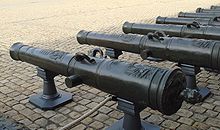| Jean Maritz | |
|---|---|
| Born | 1680 Burgdorf, Old Swiss Confederacy |
| Died | 1743 (1744) (aged 63) |
| Nationality | Swiss |
| Occupation | Engineer |
| Children | Jean Maritz II |
| Engineering career | |
| Significant design | Vertical drilling machine, horizontal drilling machine for cannons |
| Significant advance | Gun tube boring |
Jean Maritz (1680–1743), also Johan Maritz, was a Swiss inventor, born in Burgdorf, Canton of Bern, who moved to France, becoming "Commissaire des Fontes" at Strasbourg (Commissioner of the King's Foundry), and invented the vertical drilling machine, as well as the horizontal drilling machine for cannons in the 18th century. His inventions revolutionized cannon-making and became a key component of the de Vallière system and contributed to the development of the later Gribeauval system.


Jean Maritz first invented a vertical drilling machine for cannons while in France in 1713. The vertical drilling method however, in which a cannon was slowly lowered over a turning drill, was very delicate, very time consuming and rather imprecise.



He further developed a method for the horizontal drilling of cannons around 1734. These methods involved the drilling of a bore from a solid casting.
These inventions were vast improvements over previous methods, which involved founding the cannon around a clay core, which was removed after founding, leading to imprecision and shifting of the core, and therefore poor performance.


The inventions of Jean Maritz gave perfectly straight bores which could perfectly fit the ball diameter, and therefore vastly increase efficiency. In the horizontal method developed by Maritz, the solid-cast cannon itself was revolved horizontally, while the drill remained static, in a method similar to that of a lathe.
The son of Jean Maritz, Jean Maritz II (1712-1790), who had worked with his father on the development of boring, became Inspector General of Gun Foundries in 1755. He is credited with the innovation of the horizontal boring machine which can be seen in these images https://www.photo.rmn.fr/archive/06-526761-2C6NU0PLJPKE.html https://www.photo.rmn.fr/archive/06-526762-2C6NU0PLJZSL.html
The Maritz method would be central in the development of the Gribeauval cannon.
See also
Notes
- ^ A Dictionary of Military History and the Art of War by André Corvisier p.331
- The Pirotechnia of Vannoccio Biringuccio by Vannoccio Biringuccio p.223
- An Encyclopaedia of the History of Technology by Ian McNeil, p.396
- ^ Louis Xv's Navy, 1748-1762 by James S. Pritchard p.151-152
- ^ 50 Military Leaders Who Changed the World by William Weir p.132
- The gun-founders of England by Charles Foulkes p.17
- "Réunion des Musées Nationaux-Grand Palais -". www.photo.rmn.fr. Retrieved 2023-12-21.
- Napoleon's Guns, 1792-1815 by René Chartrand, Ray Hutchins p.6
| De Vallière system | ||
|---|---|---|
| Cannons | ||
| Mortars | ||